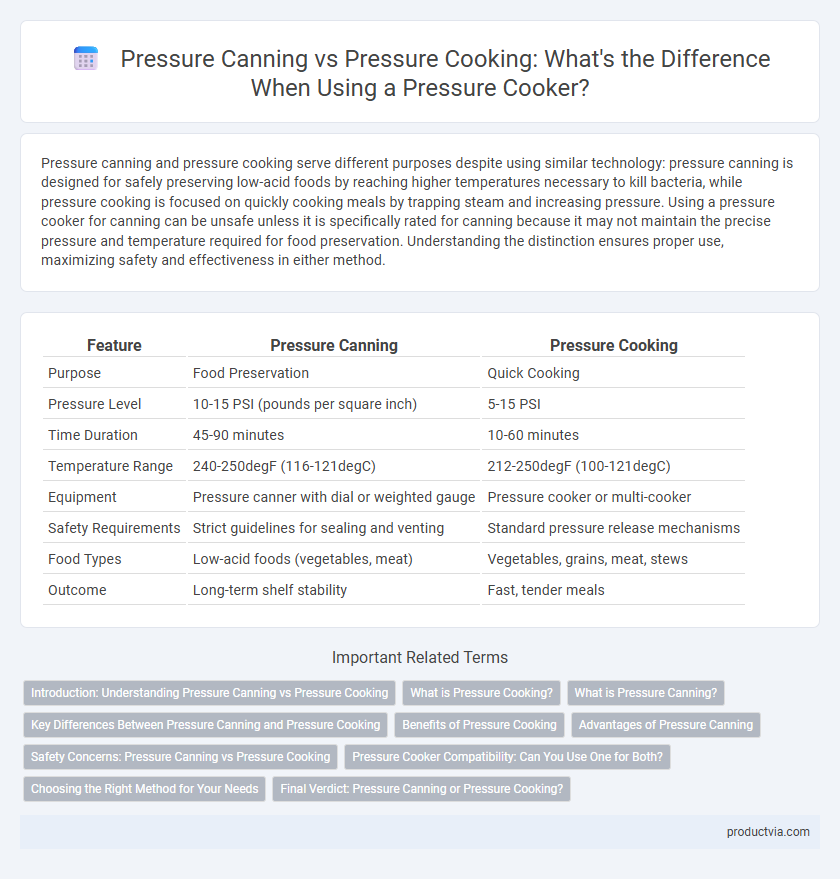Pressure canning and pressure cooking serve different purposes despite using similar technology: pressure canning is designed for safely preserving low-acid foods by reaching higher temperatures necessary to kill bacteria, while pressure cooking is focused on quickly cooking meals by trapping steam and increasing pressure. Using a pressure cooker for canning can be unsafe unless it is specifically rated for canning because it may not maintain the precise pressure and temperature required for food preservation. Understanding the distinction ensures proper use, maximizing safety and effectiveness in either method.
Table of Comparison
| Feature | Pressure Canning | Pressure Cooking |
|---|---|---|
| Purpose | Food Preservation | Quick Cooking |
| Pressure Level | 10-15 PSI (pounds per square inch) | 5-15 PSI |
| Time Duration | 45-90 minutes | 10-60 minutes |
| Temperature Range | 240-250degF (116-121degC) | 212-250degF (100-121degC) |
| Equipment | Pressure canner with dial or weighted gauge | Pressure cooker or multi-cooker |
| Safety Requirements | Strict guidelines for sealing and venting | Standard pressure release mechanisms |
| Food Types | Low-acid foods (vegetables, meat) | Vegetables, grains, meat, stews |
| Outcome | Long-term shelf stability | Fast, tender meals |
Introduction: Understanding Pressure Canning vs Pressure Cooking
Pressure canning and pressure cooking both utilize high-pressure steam but serve distinct purposes; pressure canning is designed for safely preserving low-acid foods by reaching temperatures that destroy harmful bacteria like Clostridium botulinum. Pressure cooking focuses on rapidly cooking meals by increasing the boiling point of water, significantly reducing cooking time. Understanding the specific design and function of your pressure cooker ensures safe and effective use for either canning or cooking applications.
What is Pressure Cooking?
Pressure cooking uses high-pressure steam inside a sealed pot to cook food quickly, retaining nutrients and enhancing flavors. Unlike pressure canning, which safely preserves low-acid foods by eliminating harmful bacteria, pressure cooking is primarily designed for fast meal preparation rather than long-term food storage. The pressure inside the cooker typically reaches 15 psi, raising boiling temperatures and reducing cooking times significantly.
What is Pressure Canning?
Pressure canning is a specialized method of preserving low-acid foods by processing them in a pressure cooker at temperatures above boiling point, ensuring the destruction of harmful bacteria like Clostridium botulinum. Unlike pressure cooking, which focuses on rapid meal preparation, pressure canning uses precise time and pressure controls to create a vacuum seal, extending shelf life safely. This process is essential for home canning vegetables, meats, and soups to prevent foodborne illnesses.
Key Differences Between Pressure Canning and Pressure Cooking
Pressure canning uses a pressure cooker designed to reach and maintain precise temperatures above boiling point for extended periods, ensuring the safe preservation of low-acid foods by destroying bacteria and spores. Pressure cooking focuses on cooking food quickly by increasing pressure and temperature to reduce cooking times, without the stringent temperature control required for canning. The key difference lies in pressure canning's strict safety protocols and timing to prevent foodborne illnesses, while pressure cooking prioritizes speed and texture improvement in meal preparation.
Benefits of Pressure Cooking
Pressure cooking utilizes high steam pressure to rapidly cook food, significantly reducing cooking time while preserving nutrients and enhancing flavor. Unlike pressure canning, which is designed for safely preserving low-acid foods by sterilizing jars under pressure, pressure cooking is ideal for everyday meal preparation, offering convenience and energy efficiency. The benefits of pressure cooking include tenderizing tough cuts of meat, maintaining moisture, and delivering consistent results with minimal supervision.
Advantages of Pressure Canning
Pressure canning offers superior food preservation by reaching higher temperatures around 240degF, effectively eliminating harmful bacteria and spores, which pressure cooking alone cannot achieve. This method extends shelf life for home-canned goods up to a year or more without refrigeration. Pressure canning also ensures nutrient retention and flavor preservation in low-acid foods like vegetables and meats, making it a safe and efficient option for long-term storage.
Safety Concerns: Pressure Canning vs Pressure Cooking
Pressure canning uses a pressure cooker designed to reach higher temperatures and maintain precise pressure levels to safely preserve low-acid foods, effectively preventing botulism. Pressure cooking operates at lower pressures suitable for fast meal preparation but does not guarantee the elimination of harmful bacteria for long-term storage. Understanding these safety distinctions is crucial to avoid foodborne illnesses when using a pressure cooker for canning versus cooking.
Pressure Cooker Compatibility: Can You Use One for Both?
Pressure canning requires a pressure cooker specifically designed for canning, featuring precise pressure control and a locking lid to maintain safety during extended cooking times. Regular pressure cookers may not have these safety features, making them unsuitable for pressure canning despite being compatible for pressure cooking meals. Always verify the manufacturer's guidelines to ensure your pressure cooker model supports pressure canning to avoid food safety risks.
Choosing the Right Method for Your Needs
Pressure canning uses precise temperature control and high pressure to safely preserve low-acid foods by eliminating harmful bacteria, making it essential for long-term storage of vegetables and meats. Pressure cooking employs high pressure to rapidly cook meals, enhancing flavor and texture without the extended preservation process. Selecting pressure canning or pressure cooking depends on whether your goal is food safety and shelf life or quick meal preparation.
Final Verdict: Pressure Canning or Pressure Cooking?
Pressure canning uses higher temperatures and longer cooking times to safely preserve low-acid foods by eliminating harmful bacteria and spores, making it essential for long-term food storage. Pressure cooking decreases cooking time by using steam pressure to rapidly tenderize food, ideal for day-to-day meal preparation but not safe for canning purposes. For safety and preservation, pressure canning is recommended when storing foods long-term, while pressure cooking is best suited for quick cooking tasks.
Pressure canning vs Pressure cooking for pressure cooker Infographic

 productvia.com
productvia.com